![]()
![]()
![]()
Use LEFT and RIGHT arrow keys to navigate between flashcards;
Use UP and DOWN arrow keys to flip the card;
H to show hint;
A reads text to speech;
94 Cards in this Set
- Front
- Back

|
Phidias - Athena Parthenos (Virgin)
- model of the lost chryselephantine (gold & ivory) statue * approximately 38’ tall |
|

|
The Golden Section (ratio)
– first written about by Euclid in The Elements (300 BCE) -resembles natural spirals in growth of shells -constant relationship by growing * sides of squares in Fibonacci sequence |
|
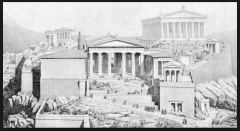
|
Reconstruction Drawing of the Acropolis
- Athens, Greece * from west |
|
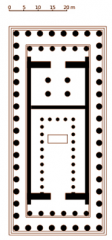
|
Iktinos & Kallikrates - Floor Plan of the Parthenon, Temple of Athena Parthenos
447-432 BCE * Doric order- recognizable building format that can be easily recreated -Ionic capitals |
|
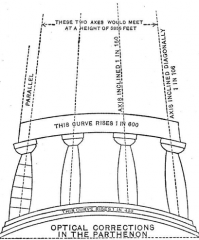
|
Exaggeration of the swelling of the stylobate on the Parthenon
447-432 BCE * theories of refinements: compensation( for us to optically see) exaggeration, tension * columns (doric) meet 4500 m above |
|
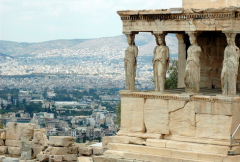
|
Erectheion, Acropolis
* ionic columns |
|
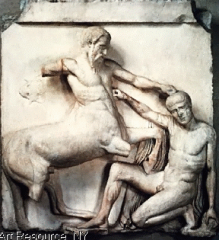
|
Metope: Lapiths versus the Centaurs
-sense of superiority over barbariansim. -bassrelief |
|
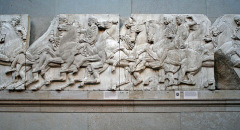
|
Parthenon Frieze: Horsemen marshal procession (West) and in procession (North)
* horses - good notion of anatomy, motion |
|

|
Parthenon Frieze: Sacrificial animals and Unmounted Horsemen (North)
|
|
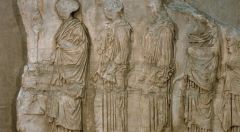
|
Parthenon Frieze: Maidens with incense and sacrificial vessels (North)
|
|
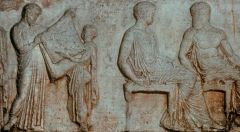
|
Maidens bringing peplos (worn by gods) to chief priest: seated deities (Athena and Hephasitos) (East)
|
|
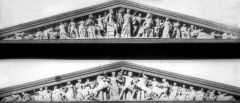
|
Reconstructions of Eastern and Western Pediment
* originally painted |
|
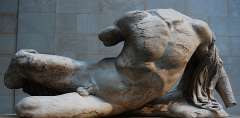
|
West pediment: Ilissos, river God of Athens
|
|

|
East Pediment: Hestia, Dione, and Aphrodite
-drapery |
|
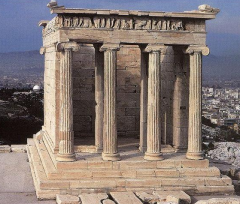
|
Kallikrates - Temple of Athena Nike, Acropolis, Athens
* ionic columns |
|
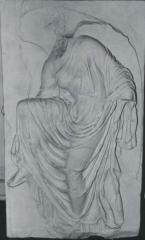
|
Nike Adjusting her Sandal, from south side of the parapet of the Temple of Athena Nike, Acropolis
-seemingly normal activity done by god |
|
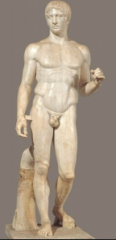
|
Polykleitos - Doryphoros (Spear Bearer)
- Roman marble copy from Pompeii, Italy after a bronze original |
|

|
Kouros
- marble * 6’1/2” high |
|
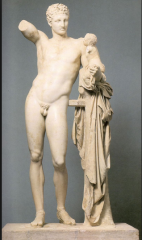
|
Praxiteles - Hermes and Infant Dionysos
- marble |
|
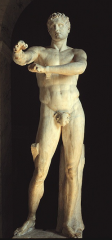
|
Lysippos - Apoxyomenos (The Scraper)
- marble, original bronze * enhanced engagement with the viewer |
|
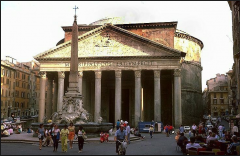
|
Pantheon
447-432 BCE * spherical dome w/ opening (occulus) in the center - connection to the gods (houses ALL the gods) * concrete |
|

|
Manuscript Illumination: Celestial City from The Trinity Apocalypse
|
|
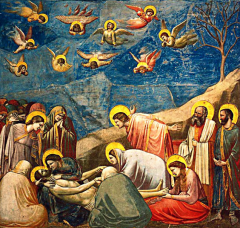
|
Giotto - Lamentation
- fresco * renaissance - Christ as human, emotions -paints jesus as normal person -went back to greek style like humans are on level w/ gods |
|
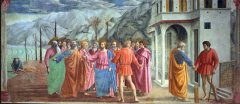
|
Masaccio - Tribute Money
- fresco * vanishing point - Christ's head * contrapposto movement * engagement with light (corresponding to the real source of light) -atmospheric perspective- colors get more saturated and fuzzy as they get farther back, like mountains. |
|
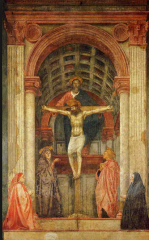
|
Masaccio - Trinity
- Fresco * the space can be worked out backwards from the depiction * dove holy spirit |
|

|
Leonardo - Virgin of the Rocks
- oil on panel |
|
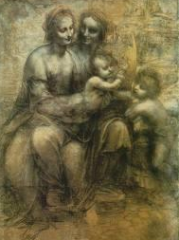
|
Leonardo - Virgin and Saint Anne
- cartoon |
|
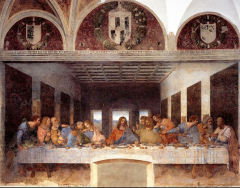
|
Leonardo - The Last Supper
- Fresco (not true - on dry wall) -table is horizon line * vanishing point - Christ's head ceiling = orthagonals * references to number 3 (trinity) * Judas reaching for bread at the same time as Jesus; holding a bag (silver?); tips over salt shaker, only disciple in darkness -behind jesus is door because he is the door |
|
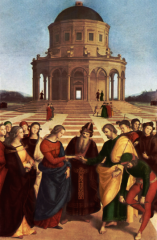
|
Raphael - Marriage of the Virgin
- oil on panel - status of the artist as intellectually recognizable figure. -head positions make you look at what is going on -guy on right is mad, breaks his stick because it didnt bloom |
|
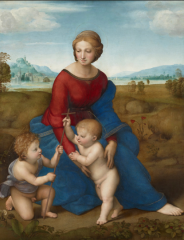
|
Raphael - Madonna of the Meadow
- oil on panel |
|
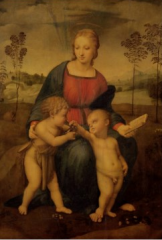
|
Raphael - Madonna of the Goldfinch
- oil on panel |
|
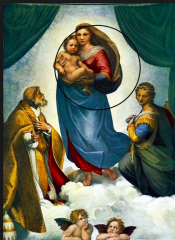
|
Raphael - Sistine Madonna
- oil on canvas * no sense of earthly space, no landscape, no procession into depth; the Virgin is separated from the material world * Pope Sixtus II and St. Barbara * altarpiece (not for private collection) * interaction with viewer, Raphael - "choreographer" |
|
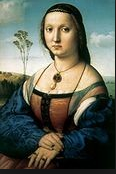
|
Raphael - Maddalena Strozzi Doni
- oil on panel |
|

|
Leonardo - Mona Lisa
- oil on panel -Spettsatura - being humble about your background -Leonardo was not religious -uneven landscape makes her face pull up and get dragged down making her left side look like she is almost smiling -created Sfumato- smoking colors together |
|
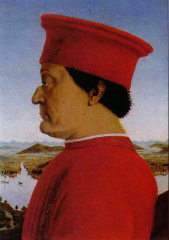
|
Piero della Francesca - Duke and Duchess of Urbino (Battista Sforza and Federigo da Montefeltro)
- oil on panel |
|
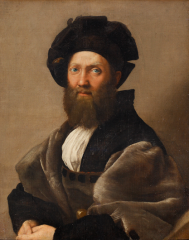
|
Raphael - Baldassare Castiglione
- oil on canvas |
|
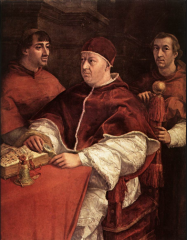
|
Raphael - Pope Leo X with Cardinals Guilio de’ Medici and Luigi de’Rossi
- oil on panel |
|

|
Leochares
Apollo Belvedere |
|

|
Verrocchio - David
- Bronze |
|
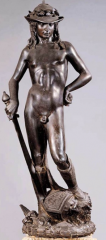
|
Donatello - David
- Bronze |
|
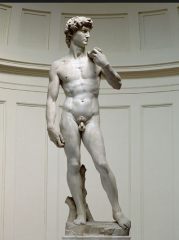
|
Michelangelo - David
- Marble (Carrare) * tradition of Davids in Florence * sculptural theory of subtraction- remove pieces to reveal the true sculpture * head / hands disproportional * inspired by Belvedere torso & Spear Bearer -classic image of high renaissance -contropossto -looks calm, very muscular -M participated in dissection, great sense of body detail. -more detail in hands and face as compared to Praxitilies |
|
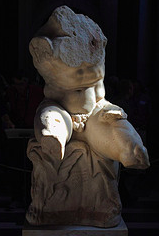
|
Belvedere Torso
- Marble |
|
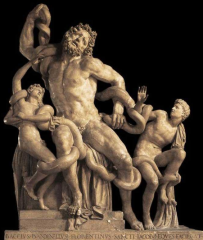
|
Laocoon and his Sons
- Marble |
|
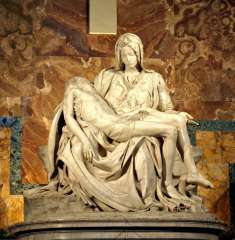
|
Michelangelo - Pieta
- Marble * Mary is big/strong because of drapery * light / shadow/depth * Michelangelo signed over drapery -high renaissance sense of the individual -sense of peace on face -Mich was very religious man |
|
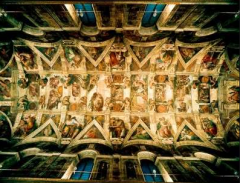
|
Michelangelo - The Sistine Ceiling
- 1508-12 - fresco * neoplatonism * architecture (niches, structure etc.) painted! * contrast of light and shade * theme: Genesis |
|
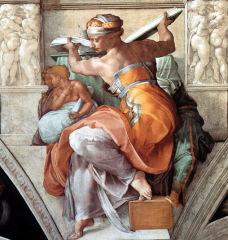
|
Michelangelo - Libyan Sybil (Sistine)
- 1508-12 |
|
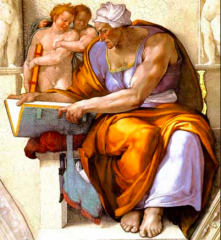
|
Michelangelo - Cumean Sybil (Sistine)
- 1508-12 |
|
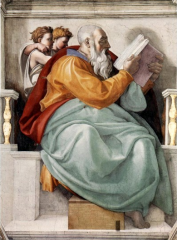
|
Michelangelo - Zechariah (Sistine)
- 1508-12 |
|
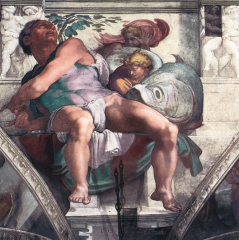
|
Michelangelo - Jonah (Sistine)
- 1508-12 * guides us in * legs compensate for the curvature of the ceiling - interaction * struggle (neoplatonism) |
|
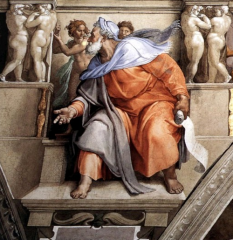
|
Michelangelo - Ezekiel (Sistine)
- 1508-12 -shows active life, about to stand up |
|
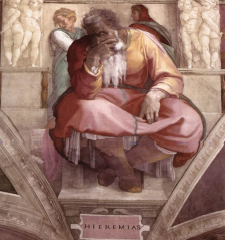
|
Michelangelo - Jeremiah (Sistine)
- 1508-12 -shows contemplative life |
|

|
Michelangelo - Ignudi (Sistine)
- 1508-12 |
|
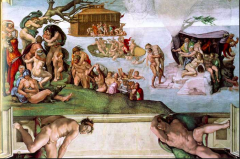
|
Michelangelo - The Flood (Sistine)
- 1508-12 -noah is waving from window -lots of people, took lots of time -First section M worked on |
|
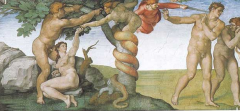
|
Michelangelo - The Temptation (Sistine)
- 1508-12 -Eve looks haggard after eating apple |
|
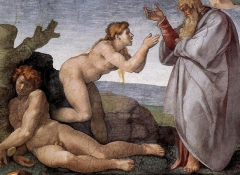
|
Michelangelo - The creation of Eve (Sistine)
- 1508-12 |
|

|
Michelangelo - Creation of Adam (Sistine)
- 1508-12 * God in movement * tension |
|
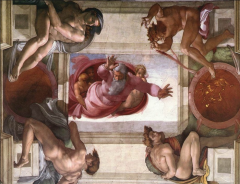
|
Michelangelo - Separation of Land and Water (Sistine)
- 1508-12 |
|
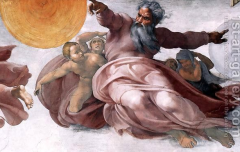
|
Michelangelo - Creation of the Sun, Moon and Plants (Sistine)
- 1508-12 |
|

|
Michelangelo - Separation of Light and Dark (Sistine)
- 1508-12 -made in one day -fresco |
|

|
Michelangelo - Last Judgement (Sistine)
- fresco > The Damned Rowed by Charon -embodies notion of high renaissance |
|
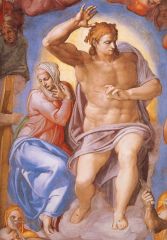
|
Michelangelo - Last Judgement (Sistine)
- fresco > Christ and Virgin Mary -M looks back at Greek and Roman sculpture and excels at it -most concerned with human form, form is divine -jesus had greek body form -image of the era after the sack of Rome and Protestant counter reformation |
|
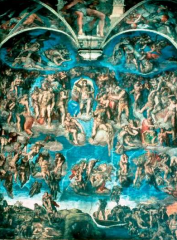
|
Michelangelo - Last Judgement (Sistine)
- fresco * counter-reformation * hieratic scale again |
|
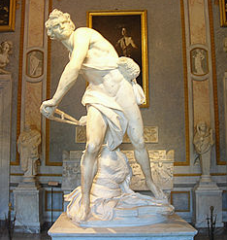
|
Bernini - David
- marble * classic image of Baroque * Goliath is behind (discobulos) * engagement w/ space * equating w/ painting, not classical -implies things are included you cant see |
|
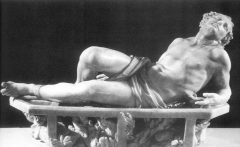
|
Bernini - The Martyrdom of St. Lawrence
- marble * context of oppression -B. changes from M's style by showing lots of movement and emotion -Baroque- new active relationship and sense to provide pictorial effect with invisible components. |
|
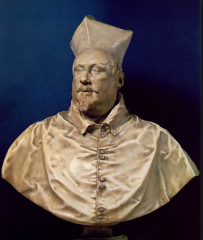
|
Bernini - Portrait Bust of Cardinal Scipione Borghese
- marble * tight buttons * about to speak |
|

|
Bernini - Apollo and Daphne
- marble * transformation/metamorphoses -dramatic and theatrical -passion B wanted to prove sculpture was equal to painting |
|

|
Bernini - Pluto and Persephone
- marble |
|
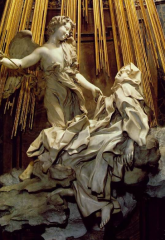
|
Bernini - Ecstasy of St. Theresa
-marble and stucco * total work of art * passion * metafictional -weighty yet weightless |
|
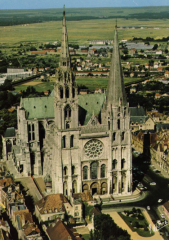
|
Chartres, Cathedral
|
|
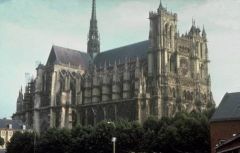
|
Amiens Cathedral, Robert de Luzarches, Thomas de Corment, Renaud de Corment
- 1220-1269 - Exterior and aerial Views -3 doors symbolize holy trinity -laid out as cross w/ steeple in center -7 is # of holy spirit. There are 7 boxes leading to nave. 4 is # of nature, 3 is # of heaven * tallest cathedral in France |
|
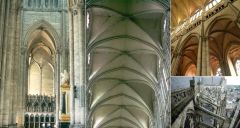
|
Essential Architectural Developments of the Gothic Style:
> Pointed Arch > Ribbed Groin Vaulting > Supporting Columns > Flying Buttress- allow more windows= more light, very important in gothic architecture * bigger windows * thinner walls * no concealing - truth, true beauty * "God, the divine architect" * "anti-classical": static, not physical - just spiritual |
|
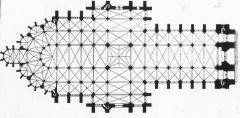
|
Amiens Cathedral, Robert de Luzarches, Thomas de Corment, Renaud de Corment
- 1220-1269 - Cathedral Plan * geometry > perfection > closeness to god |
|
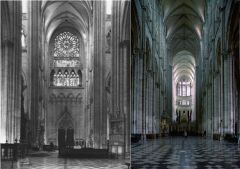
|
Amiens Cathedral, Robert de Luzarches, Thomas de Corment, Renaud de Corment
- 1220-1269 - Interior View of the Nave -cathedral is a model of the cosmos, shows a world to come |
|

|
Amiens Cathedral, Robert de Luzarches, Thomas de Corment, Renaud de Corment
- 1220-1269 - Triforium, Clerestory, and Arcade along with Elevation Drawing |
|
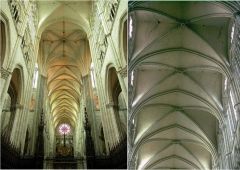
|
Amiens Cathedral, Robert de Luzarches, Thomas de Corment, Renaud de Corment
- 1220-1269 - Ceiling Vaults |
|

|
Amiens Cathedral, Robert de Luzarches, Thomas de Corment, Renaud de Corment
- 1220-1269 - High Altar with (7) Radiating Chapels |
|
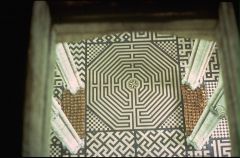
|
Amiens Cathedral, Robert de Luzarches, Thomas de Corment, Renaud de Corment
- 1220-1269 - Labyrinth -represents notion of the journey * in the center of the floor plan |
|
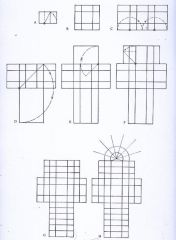
|
Amiens Cathedral, Robert de Luzarches, Thomas de Corment, Renaud de Corment
- 1220-1269 - Unfolding Plan -hieratic form, built to religious math proportions * golden section-based * see religious symbols and numbers (3, 7, 12, ...) represented |
|
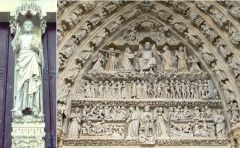
|
Amiens Cathedral, Robert de Luzarches, Thomas de Corment, Renaud de Corment
- 1220-1269 - Western Façade, Central Portal: > Beau Dieu (stamping on a beast) > Christ as Judge between the Virgin and St. John with Instruments of the Passion held by angels (top) > Resurrection of the Dead (bottom) > The Saved Received into Heaven (middle) > The Damned sent to Hell (middle) * figures twice the life size; * hieratic scale (JC - biggest) * realistic, traditional, static |
|
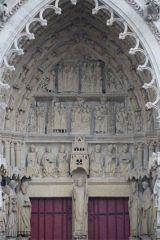
|
Amiens Cathedral, Robert de Luzarches, Thomas de Corment, Renaud de Corment
- 1220-1269 - Western Façade, Left Portal: > St. Firmin > The Invention and Procession of the Relics of St. Firmin -images/sermons in stone because people were illiterate |
|
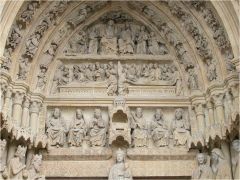
|
Amiens Cathedral, Robert de Luzarches, Thomas de Corment, Renaud de Corment
- 1220-1269 - Western Façade, Right Portal: > Virgin Mary (standing on Adam & Eve) > The Dormition and Assumption of the Virgin (middle) > Coronation of the Virgin (top) |
|

|
Raphael - Stanza della Segnatura
- 1508-11 * circles / squares - divine knowledge * segnatura = seal (octagon in the center) |
|
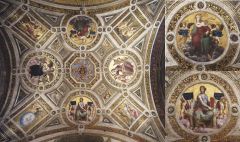
|
Raphael Stanza della Segnatura
- 1508-11 - Ceiling – Personifications: > Theology > Philosophy --embodies renaissance style 4 perspective paintings are allegories -popes hat in center showing knowledge of god through him |
|
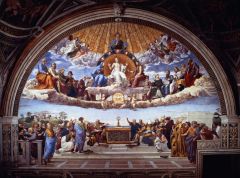
|
Raphael Stanza della Segnatura
- 1508-11 - The Disputa * below Theology * wafer / communion - vanishing point * personified God - holding a globe * 4 books - 4 gospels * circles X squares -holy spirit bird points down between books like reading illuminates you to holiness -puti in clouds in background like Raphael, sistine madonna raphael = culture and art Jesus portrays human and divine together |
|

|
Raphael Stanza della Segnatura
- 1508-11 - The School of Athens * below Philosophy * representation of St. Peter's basilica * Plato and Aristotle in center (vanishing point) They stand in front of door like jesus in last supper * sculptures of Athena (wisdom) and Apollo (light) -Michelangelo is at bottom -Epicureus is eating |
|
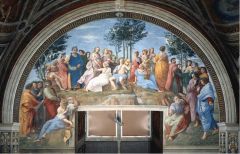
|
Raphael Stanza della Segnatura
- 1508-11 - Parnassus * poetry, arts circle painting nearby * Apollo up top w/ muses -uses a natural landscape -apollo resembles jesus -poets signified by laurel wreath (ovid, homer, dante, woman) |
|

|
Michelangelo, Tomb of Pope Julius II
> reconstruction of the first plan > reconstruction of the second plan > completed tomb in S. Pietro in Vincoli, Rome * "Tragedy of the Tomb" * counter-reformation |
|
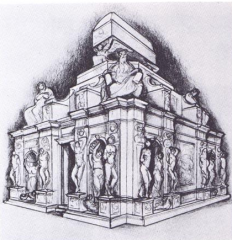
|
Michelangelo - Tomb of Pope Julius II
> reconstruction of the first plan > reconstruction of the second plan > completed tomb in S. Pietro in Vincoli, Rome -Moses shown as active and contemplative life -Panofsky description of M.'s forms |
|
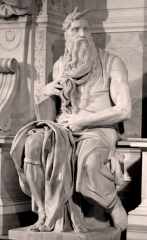
|
Michelangelo - Moses
- Marble -has horns because he just saw jesus/revelation of the divine |
|

|
Michelangelo - Captives
> The Dying Slave > Rebellious Slave - Marble -compact forms/integrity of block * inspired by Laocoon and his sons |
|
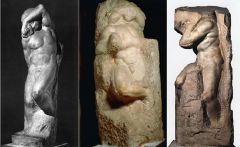
|
Michelangelo, Late Slaves
- Marble > The Young Slave > The Awakening Slave > Atlas (Prisoner) * escaping from the rock |
|
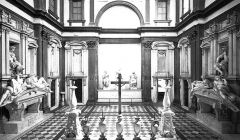
|
Michelangelo - The Medici Tombs
- 1519-34 Medici Chapel * unfinished *engagement with neoplatonism and christian thought |
|
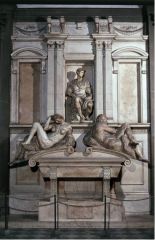
|
Michelangelo - The Medici Tombs
- 1519-34 > Tomb of Guiliano de Medici with figures of Night and Day -jupiter * active |
|
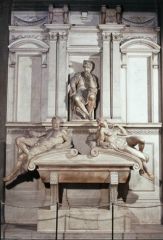
|
Michelangelo, The Medici Tombs
- 1519-34 > Tomb of Lorenzo de Medici with figures of Dusk and Dawn saturn * contemplative |

